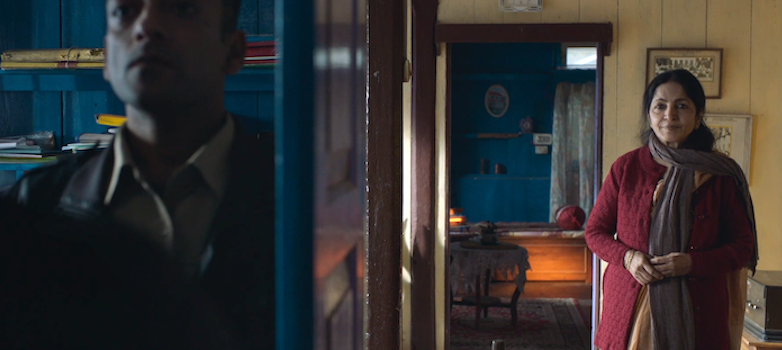In Kaisi Ye Paheli (2025), first-time director Ananyabrata Chakravorty explores the template of a hill-town crime drama through a deeply personal tale of unresolved grief and emotional neglect. The narrative, focusing on a 60-year-old woman who volunteers herself into a puzzling homicide investigation, is more than a procedural. It is a piercing study of parental distance and domestic erasure. The film had its world premiere at the recently concluded New York Indian Film Festival (NYIFF).
In the quiet hill town of Shottipur, West Bengal, the death of a 19-year-old girl in her paying guest room sends shockwaves throughout the community. As police officers Tamang (Chittaranjan Giri), Uttam (Sukant Goel) and Gogoi (Rahul Mukhia) begin their inquiry, political pressure mounts to declare it a suicide as a major tourism event is about to happen. Uttam’s mother, Ma (Sadhana Singh), quietly challenges the official theory and soon finds herself drawn into the case. But when one of the officers mysteriously disappears, the case now carries the disturbing markings of a possible serial killer. With trust in the local police deteriorating, higher authorities bring in Bondo (Rajit Kapur), a seasoned detective from the plains, to solve the mystery.
What sets Kaisi Ye Paheli apart is its quietly confident use of minimalism. This is a film that resists the temptation to overstate, whether through character count, location sprawl, or dramatic flair. It is the understated handling of events that lends the film its authenticity. Nowhere is this more evident than in the portrayal of Ma, the widowed mother who gradually embroils herself in the investigation. She isn’t romanticised as some late-blooming genius or quirky sleuth. Instead, her intelligence is rooted in observation, empathy, and years of absorbing detective fiction by Satyajit Ray, Agatha Christie, and the like. She doesn’t deduce so much as she listens, quietly noticing what others miss. There’s even a shadow of ambiguity to her backstory. She claims to have helped her late husband, a police officer, solve cases. Her son, Uttam, isn’t convinced, and crucially, the film doesn’t force us to be either. Ma has spent years tucked into the margins, her insight politely ignored, her intellect unacknowledged. Which is why the central relationship in the story between a son who can’t see his mother clearly and a mother who won’t stop trying to be seen is far more than just emotional scaffolding for a murder plot.
Uttam, in many ways, is the film’s most quietly conflicted figure. As a police officer, he is competent but blinkered. As a son, he teeters on the edge of contempt, treating Ma not as a person of intellect and experience but as a relic of domesticity. There’s also a revealing fragility to the way he engages with women. Around his mother and his girlfriend, there’s a noticeable edge to his behaviour, which is a defensiveness, a need to assert control. His ego flares, subtly but tellingly. Yet when surrounded by male colleagues, that tension dissolves. It is a portrait not just of wounded masculinity, but of a man undone by proximity to women who see him too clearly.
The arrival of Bondo, the film’s third key character, signals an important shift in tone. Played with smug precision, he represents institutional arrogance, disregarding local insight, and relying solely on the power granted by his political bosses. Sent by ‘Didi’, a thinly veiled nod to West Bengal’s incumbent Chief Minister, he’s tasked with cleaning up the mess. His very presence lays bare the fissures within the Shottipur police force, as unlike the local officers, Bondo is sharper, more calculating, and unencumbered by personal ties to the community. In one striking exchange, a terse argument with a local officer touches on the subtle socio-cultural divide between the plains and the hills. The film avoids turning this into overt political commentary. But the nuance is unmistakable.
The film’s strong focus on character-driven storytelling does come at a cost. The investigation itself, while serviceable, lacks the intricacy one might expect. Given the references to literary influences, there’s an expectation that the procedural elements might mirror their layered plotting and deft use of misdirection. Instead, the investigative thread remains relatively straightforward. It eschews the kind of narrative complexity or red herrings that typically define the genre. One could argue this was a deliberate choice to keep the story grounded, emotionally accessible. But it does give one a feeling that the film holds back from fully realising its genre potential. However, the reveal of the killer is genuinely startling, delivering a jolt that both surprises and, to some extent, redeems the simplicity of the path leading there.
Sadhana Singh, in particular, brings a gentle authority to Ma, inhabiting her character’s blend of vulnerability, intellect, and quiet defiance. Sukant Goel convincingly conveys the inner conflict of a man torn between professional duty and unresolved familial tensions. Rajit Kapur, meanwhile, lends both warmth and gravitas to a character who wears his professional pride like a badge of honour. There’s a subtle layer of meta-text here too: known to many as the detective Byomkesh Bakshi, Kapur’s very presence evokes the legacy of a fictional detective whose sharpness and integrity have influenced Ma’s sense of justice. And Chittaranjan Giri, despite limited screen time, delivers a quietly resonant performance as a man entangled in the machinery of bureaucratic decay
Leena Patoli’s cinematography is restrained. The framing serves the story rather than indulging in visual spectacle. The editing by Prakhar Khare maintains a measured pace that allows the emotional beats to land without manipulation. The sound design by Varun Arshiid and Vandana Ramakrishna is finely calibrated, shaping the atmosphere through careful restraint.
Kaisi Ye Paheli is not merely a murder mystery. It is about an individual who, long relegated to the margins, becomes something darker. Not by choice, but through tragedy. This is a tale where the unexpected doesn’t just occur, it shifts the moral centre of the story.
Hindi, Mystery, Drama, Color


